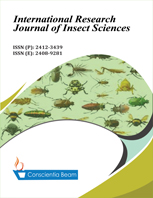Mechanisms of the Decline in Reproductive Fitness with Age in the Moth Spodoptera Litura
Abstract
Although several hypotheses have been proposed, the mechanisms underlying the decline in reproduction of insects with age remain unclear. In this study, the effect of aging on the reproductive performance of both sexes was studied in Spodoptera litura. Aging in both sexes significantly reduced reproductive fitness. Female aging had a significantly stronger effect than male aging on fecundity and fertility. This study clearly demonstrates that oviposition by virgin females is an important contributor to the decline in female fecundity with delayed mating. However, the reduction in fecundity in females mated late relative to females mated early was much greater than (almost three times) the number of eggs laid by virgin females before mating. What accounts for this additional loss in fecundity? To answer this question, egg production, oosorption, mating frequency and longevity in both sexes were analysed. The results suggest that S. litura females may emerge with extra nutrient reserves that can be allocated to adult survival and egg production; delayed mating may cause females to allocate more resources towards survival, leaving less for egg production after mating relative to females mated young. This mechanism is likely the key cause of the decline in fecundity due to aging. In addition, the fertility rate was significantly influenced by female, but not male, age at mating, suggesting that senescence degraded egg quality but not sperm quality. The results of this study also showed that the mating frequency of moth pairs was negatively correlated with male age at mating, which is likely the primary mechanism underlying the negative effects of male aging on female reproductive success.

